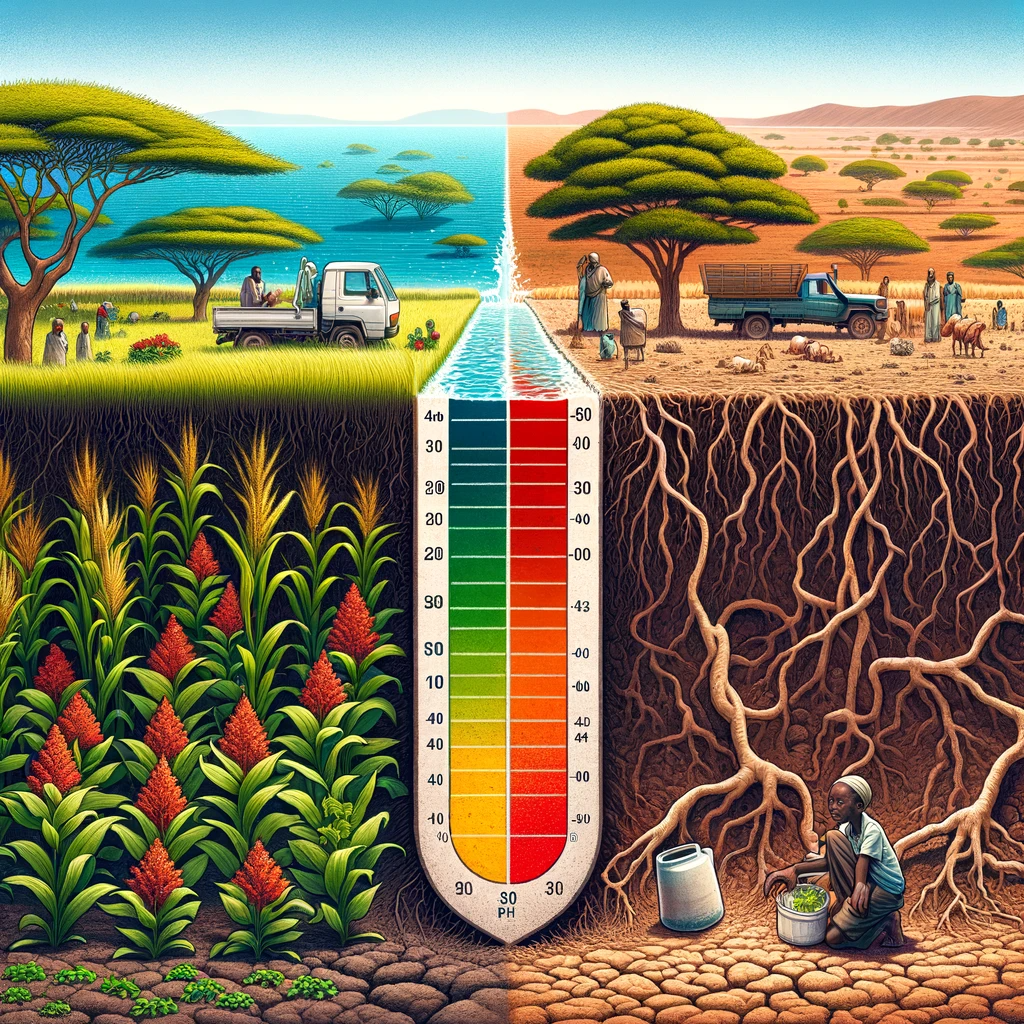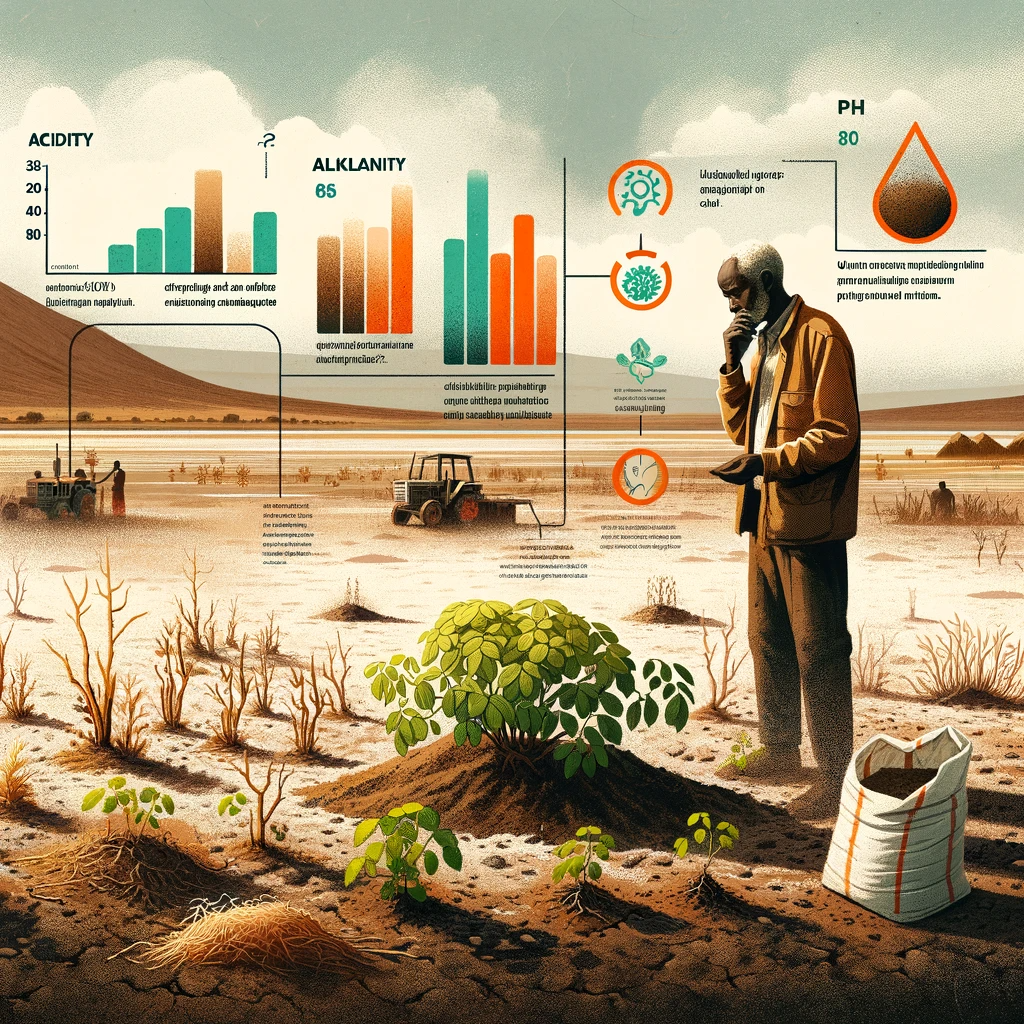By Anthony Muchoki
The agricultural backbone of East Africa, predominantly sustained by smallholder farmers, is currently facing a daunting challenge: the degradation of soil quality. Key issues such as soil acidity and alkalinity, low organic matter, and nutrient depletion are not just agricultural concerns; they are economic and social emergencies.
A distinguished Soil Scientist and coordinator of The Guiding Acid Soil Management Investments in Africa (GAIA) in Tanzania with his extensive experience in soil science, emphasizes the often underestimated impact of soil pH imbalance on agricultural productivity.
He refers to soil acidity and alkalinity as “silent killers” that stealthily degrade soil health, leading to reduced crop yields and lower quality produce. This issue, he points out, is particularly prevalent in various regions of Tanzania, where subtle shifts in soil pH have significant repercussions for the agricultural sector, affecting both food security and the livelihoods of smallholder farmers.

According to Dr. Meliyo, one of the biggest challenges in combating these “silent killers” is their detection. Soil acidity and alkalinity often do not manifest visible symptoms until crop health visibly deteriorates. This delay in detection makes mitigation efforts more complicated and time-sensitive. Dr. Meliyo advocates for regular soil testing as a crucial step in early detection. He also stresses the importance of educating farmers about the signs of soil pH imbalance and effective, locally available remedies, such as the use of lime or organic compost, to counteract these issues.
Under Dr. Meliyo’s coordination, The Guiding Acid Soil Management Investments in Africa (GAIA) in Tanzania, plays a pivotal role in addressing these soil health challenges. GAIA focuses on research and development of sustainable soil management practices, tailored to the unique needs of different regions in Tanzania and beyond. The initiative also works on disseminating this knowledge among farmers and agricultural stakeholders. Dr. Meliyo highlights the importance of GAIA’s work in not only providing solutions but also fostering a culture of proactive soil health management among farmers and local agricultural communities.
Dr. Meliyo strongly advocates for regional and international collaboration in tackling soil acidity and alkalinity issues. He believes that the sharing of knowledge, resources, and best practices across borders is essential for effectively managing these widespread soil health problems.
To combat soil acidity and alkalinity, a region-specific approach is crucial.
After extensive desktop research and numerous discussions with farmers across East Africa, I have come to the conclusion that combating soil acidity and alkalinity effectively requires a region-specific approach. This tailored strategy is essential to address the unique soil conditions and agricultural challenges present in different areas of East Africa. For countries like Kenya and Ethiopia, where coffee and tea are major crops, liming – the process of adding lime to soil – can neutralize acidity. In contrast, in areas with alkaline soils like parts of Tanzania and Uganda, the incorporation of organic matter can help lower the pH to a more neutral level,” she says.
Organic matter is the lifeblood of fertile soil. Composting, green manuring, and the use of cover crops are practices that need to be widely adopted across East Africa. Countries like Rwanda and Burundi, with their hilly terrain, can particularly benefit from these practices to prevent soil erosion and improve soil structure.
Depleted nutrients in soil can be replenished through integrated nutrient management (INM). This involves the combined use of chemical fertilizers and organic manure. DRC Congo and South Sudan, with their vast arable lands, stand to gain immensely from adopting INM practices.
No single country can tackle these challenges in isolation. Regional collaboration is key. The East African Community (EAC) should prioritize agricultural research and development, focusing on sustainable farming practices. Sharing knowledge and resources among member states will catalyze progress.
The empowerment of farmers through education and technology is non-negotiable. From mobile apps for soil testing to workshops on sustainable farming practices, information is power. Governments and NGOs must work together to ensure farmers have access to this vital knowledge.
A critical aspect often overlooked in agricultural discussions is water management. In arid regions of countries like Kenya and Tanzania, water scarcity exacerbates soil problems. Implementing rainwater harvesting techniques, building small-scale irrigation systems, and promoting drought-resistant crop varieties are essential measures. Regional collaboration in water resource management could lead to shared solutions for these water-stressed areas.
Para 12: Enhancing Market Access and Value Addition (100 words):
Another significant challenge is market access. Farmers often struggle to get fair prices for their produce. Establishing cooperatives and improving infrastructure like roads can greatly enhance market access. Moreover, encouraging local value addition, like processing raw agricultural products, can increase farmers’ income and stimulate local economies.
Climate change poses a significant threat to agriculture in East Africa. Developing and disseminating climate-smart agriculture practices is crucial. This includes introducing crops that are more resistant to climate extremes and teaching farmers about sustainable land management practices. A regional approach to climate change adaptation can leverage shared experiences and resources.
There is a dire need for increased investment in agricultural research. Developing new crop varieties that can withstand local soil and climate challenges is essential. Countries like Ethiopia and Uganda, with robust agricultural research programs, can play a leading role in this regard. A collective fund for agricultural research within the EAC could be a game changer.
Agroforestry, the integration of trees into farming systems, offers numerous benefits, including improving soil fertility and moisture. It can also provide additional income through products like timber and fruits. Countries like Rwanda and Burundi, with their hilly terrains, can particularly benefit from agroforestry to prevent soil erosion.
There’s an urgent need to involve more youth in agriculture. The sector is often seen as unattractive by the younger generation. By integrating technology, providing training in modern agricultural techniques, and offering incentives like startup grants, we can attract more young people to agriculture. This is vital for the sector’s long-term sustainability.
Agricultural education and extension services play a vital role in farmer empowerment. Strengthening these services with up-to-date information and technology can greatly improve farmers’ productivity. In countries like Tanzania and Uganda, mobile extension services have shown promising results in reaching remote farmers.
Gender inclusivity in farming must be prioritized. Women play a crucial role in agriculture in East Africa, yet they often have limited access to resources and training. Policies that ensure women’s access to land, credit, and education are essential for equitable agricultural development.
Public-private partnerships can bring much-needed investment and innovation to the agricultural sector. These partnerships can facilitate the introduction of new technologies and practices, enhancing productivity and sustainability. Encouraging such collaborations can be a significant step towards modernizing agriculture in the region.
To transform agriculture in East Africa, a multi-faceted approach is necessary. This includes addressing water management, market access, climate change, research, agroforestry, youth involvement, education, gender inclusivity, and public-private partnerships. A unified regional strategy, coupled with national efforts and farmer-centric policies, will be key to overcoming the existing challenges. The journey ahead is complex, but with collaborative effort and determination, East Africa can ensure a prosperous and sustainable future for its smallholder farmers.
The road to revitalizing agriculture in East Africa is challenging but achievable. With a coordinated approach focusing on soil health, organic matter enhancement, nutrient management, regional collaboration, and farmer empowerment, we can ensure the sustainability and productivity of agriculture in this region. The future of East Africa’s smallholder farmers depends on the actions we take today.
